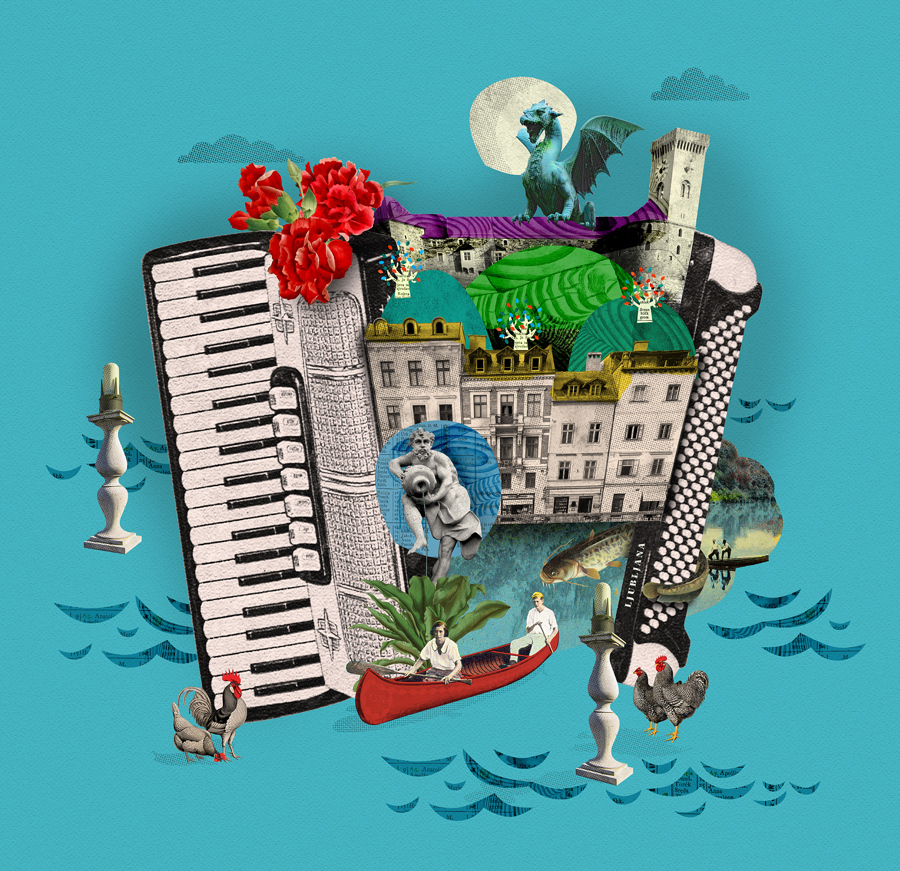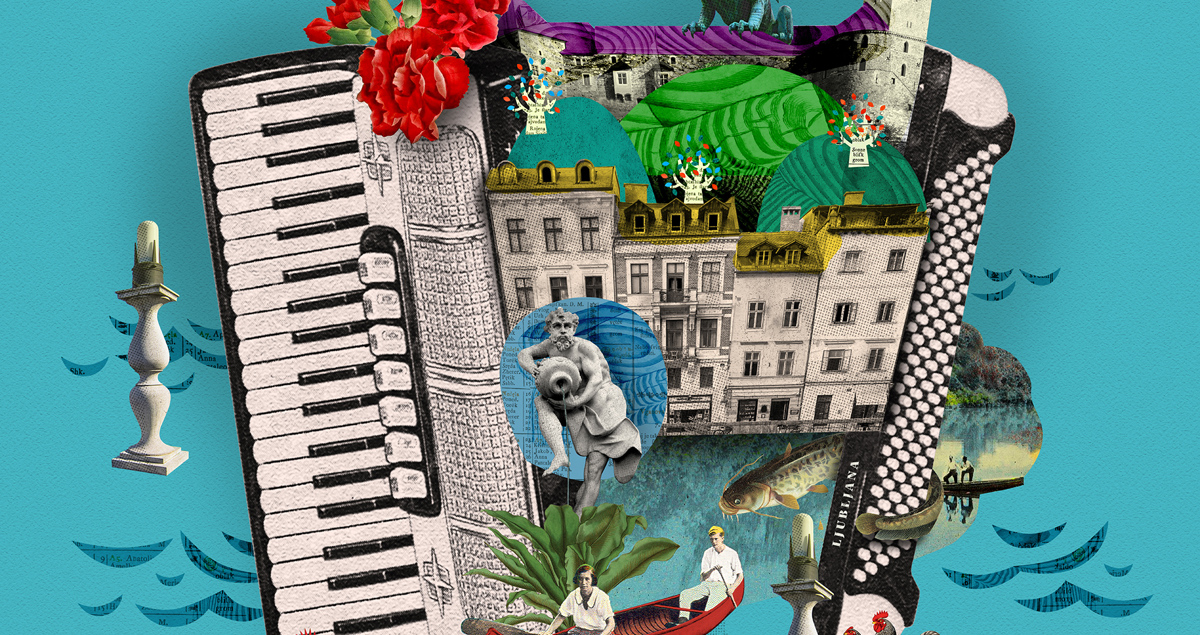C’est parce qu’on aimerait bien comprendre ce qui se cache dans le ventre des mots qui vont et viennent au quotidien dans nos univers écrits et oraux qu’on se tourne vers l’étymologie. Notre quête de réponse vise à réduire l’aspect arbitraire du langage, du moins en apparence, en nouant le signifié et le signifiant, afin de résoudre l’énigme : pourquoi ceci s’appelle comme cela ? Est-ce une question qui nous renvoie à l’enfance ? Peut-être. Pour moi, Ljubljana fait écho à mes premières années d’adulte, alors que j’y ai déménagé pour étudier à l’université. En comparaison avec le lieu de ma naissance, Maribor, une ville plus pointue, aussi bien acoustiquement que visuellement, avec ses deux r et son m lui procurant fermeté et stabilité, les l et j courbes de Ljubljana donnent à cette dernière un côté hésitant, tendre, fluide. Ljubljana coule, dirait-on. Et c’est vrai : une étroite rivière la traverse, la Ljubljanica. Si les touristes parviennent parfois à prononcer le nom de la ville, c’est rarement le cas pour celui de la rivière. Est-ce Ljubljana qui entoure la rivière ou est-ce plutôt la rivière qui serpente à travers la ville ? Qui vient en premier ? L’espace que les habitants ont voulu nommer, ou le toponyme, qui est graduellement devenu un lieu de vie habité ? Qui vient avant ? Le mot ou l’endroit ? Dans leur désir de comprendre le mot Ljubljana, bien des gens en sont venus à créer leur propre définition, la plupart d’entre elles ayant été invalidées par les linguistes modernes. Pensons par exemple au dramaturge et auteur Anton Tomaž Linhart, émettant l’hypothèse, au XVIIIe siècle, que l’origine de Ljubljana se trouvait dans le mot ljubljena, « bien-aimé ». Le titre du film Ljubljana la bien-aimée (Ljubljana je ljubljena) est une allusion à cette piste. Mentionnons également, dans l’esprit des années 1980, la célèbre chanson du groupe punk Pankrti, « Ljubljana est malade » (Lublana je bulana). D’autres associent l’origine du nom au dieu préromain de l’eau Laburus. D’autres encore au terme latin l’aliviana (aqua), qui signifie « la crue de l’eau ». Certains voient un lien entre l’eau, ou plus précisément les marais, et sa version allemande, Laibach, qui dériverait du concept d’eau « lente, stagnante ». Il n’y a bien sûr rien d’étonnant à la surenchère de ces étymologies aqueuses. En plus de la rivière, les marais de Ljubljana s’étendent au sud de la ville, là où on a retrouvé des habitats palafittiques datant de la préhistoire. Avant d’atteindre la périphérie de Ljubljana, le parcours de la Ljubljanica est assez surprenant. Rivière principalement souterraine, elle émerge sept fois – chaque fois affublée d’un nom différent : Trbuhovica, Obrh, Stržen, Rak, Pivka, Unica et, enfin, Ljubljanica. Puis, aux abords de la ville, la Ljubljanica se déverse dans le plus grand fleuve de Slovénie, le Sava. Comme la Ljubljanica apparaissant puis disparaissant, ouvrant chaque fois un nouvel œil, connue chaque fois sous un nouveau nom, l’explication étymologique de Ljubljana demeure élusive. Pourtant, le linguiste Silvo Torkar affirme que l’origine du mot Ljubljana n’a rien à voir avec les paysages de rivières et de lacs, mais qu’il est plutôt lié au nom propre Ljubovid – ou « celui qui a l’air gentil ». La rivière nommée Ljubija – une des branches de la Ljubljanica – ainsi que le nom Ljubljana découlent de ce nom propre. Une théorie qui s’appuie sur un homme. On dirait presque un conte de fées : « Un homme appelé Ljubovid vivait près d’une rivière. » Selon Torkar, Ljubljana serait donc un anthroponyme. Ce qui me semble significatif et surtout fascinant avec cette explication, c’est que même l’anthroponyme dérive de l’homme à la ville en passant par le nom de la rivière. Ljubljana se définit par l’eau – l’eau qui coule, qui change constamment, qui bloque les routes, mais qui en ouvre d’autres par le fait même. Souvent, lorsque la ville est enveloppée d’un épais brouillard, c’est sur les berges de la rivière qu’elle devient la plus charmante. La brume et le courant entrent alors en dialogue, tandis que le froid s’attaque aux os des passants transis. Un autre aspect révélateur, que j’affectionne particulièrement : Linhart, d’une certaine manière, n’avait pas tort. Il y a bel et bien une connexion entre Ljubljana et le mot ljubljena ou « bien-aimé ». La racine ljub, le signifiant de l’amour.
Ana Svetel

Ker bi radi razumeli, kaj se skriva v trebuhih besed, ki se vsak dan kot navečje samoumevnosti kotalijo po naših izgovorjenih in zapisanih svetovih, se obračamo k etimologiji. Iščemo razlage, da se jezik zazdi manj arbitraren, da se označevalec in označenec vsaj na videz prišijeta skupaj, da odgovorimo na vprašanje: zakaj se temu reče tako? Vprašanje, ki nas vrača v otroštvo? Mogoče. Ljubljana je zame povezana z zgodnjo odraslostjo, vanjo sem se priselila, ko sem začela študirati. V primerjavi z rodnim Mariborom, ki je zvočno in vizualno bolj špičast, katerega dva R-ja in M-ja besedi dajeta trdnost, stabilnost, Ljubljana zaradi svojih zavitih L-jev in J-jev zveni in izgleda obotavljivejša, mehkejša, bolj tekoča. Ljubljana, ki steče. In res – skoznjo teče majcena reka, Ljubljanica. Če tujci izgovorjavo mesta še nekako zvozijo, jim ob reki skoraj vedno spodrsne. Se Ljubljana zavija okoli rečice ali pa se Ljubljanica zvija skozi mesto? Kaj je bilo prej? Prostor, ki so ga prebivalci želeli poimenovati, ali toponim, ki so ga sčasoma naselili? Je bila prej beseda ali kraj? V želji po razumevanju besede Ljubljana so mnogi skovali svoje razlage, večino katerih sodobni jezikoslovci zavračajo. Dramatik in pisec Anton Tomaž Linhart je denimo v 18. stoletju postavil tezo, da Ljubljana izhaja iz besede ljubljena. Na to aludira tudi naslov filma Ljubljana je ljubljena. In, v duhu 80. let prejšnjega stoletja, slavni komad punk zasedbe Pankrti Lublana je bulana. Nekateri izvor povezujejo tudi s predrimskim vodnim božanstvom Laburus. Drugi z latinsko l'aluviana (aqua), kar pomeni 'voda, ki poplavlja'. Nekateri z vodo oziroma močvirjem povezujejo tudi njeno nemško ime, Laibach, kar naj bi koreninilo v pomenu 'počasna voda, ki zastaja'. Te 'vodne' etimologije seveda niso presenetljive. Poleg reke se južno od Ljubljane razprostira Ljubljansko barje, kjer najdemo prazgodovinska koliščarska naselja. Ljubljanica pa, preden priteče v Ljubljano, opravi nenavadno pot. Kot reka ponikalnica se na površju pojavi sedemkrat – in to s sedmero imeni: Trbuhovica, Obrh, Stržen, Rak, Pivka, Unica in Ljubljanica. Naposled – tako rekoč na robu mesta – se Ljubljanica izlije v največjo slovensko reko, Savo. Kot se Ljubljanica prikazuje in skriva, kakor bi vsakič trenila z drugim očesom, z drugim imenom, se skriva tudi etimološka razlaga Ljubljane. A jezikoslovec Silvo Torkar trdi, da izvor Ljubljane ni neposredno povezan z vodnimi krajinami, temveč z osebnim imenom Ljubovid – ta, ki je ljubeznivega videza. Šele iz osebnega pa je bilo tvorjeno rečno ime Ljubija – ki je eden izmed pritokov Ljubljanice, in krajevno ime Ljubljana. Ta razlaga v izhodišče postavlja človeka. Lahko bi se začela kot pravljica: „Nekoč je ob neki reki živel mož po imenu Ljubovid.“ Ljubljana je torej, po Torkarju, antroponim. Kar je zgovorno, po svoje celo prisrčno, je, da se tudi ta antroponim iz človeka do mesta prelije skozi ime reke. Ljubljano definira voda – je gibajoča, vedno spremenljiva, poti prekinja, a jih tudi omogoča. Pogosto, ko mesto ovije megla in vztraja med nami, je Ljubljana najbolj očarljiva ravno ob reki. Meglice in tekoča voda sta kakor v snovnem dialogu, medtem ko vlažni mraz opazovalcem pronica do kosti. In zgovorno, celo prisrčno, je tudi, da je Linhart imel po svoje prav: Ljubljana je povezana z besedo ljubljena. Koren ljub-, ki označuje ljubezen, je isti.
Ana Svetel
When we want to understand what is hidden in the belly of the words we use in our daily spoken and written language, we turn to etymology. In so doing we aim to reduce the arbitrary nature of language, at least in appearance, by connecting the signifier to the signified in order to answer the question: why is this called that? Does the question send us back to our childhood? Perhaps. For me, Ljubljana echoes my early adulthood, when I moved there to begin university. Compared to my native Maribor, whose two r’s and an m give it a sharper quality both acoustically and visually, evoking firmness and stability, Ljubljana’s curvy l’s and j’s make it sound and look more hesitant, softer, more fluid. Ljubljana seems to flow. And it’s true—a narrow river, the Ljubljanica, runs through it. When foreign visitors somehow manage to pronounce the name of the city, they almost inevitably slip on the river. Does Ljubljana wrap around the river or does the Ljubljanica meander through the city? Which came first? The space the inhabitants wanted to name, or the toponym, which gradually came to be inhabited? Which came first, the word or the place?
Many people fashioned their own explanations in an attempt to understand the word Ljubljana, most of which have been debunked by modern linguists. Take 18th century playwright and author Anton Tomaž Linhart, for instance, who hypothesized that Ljubljana originated from the word “beloved” (ljubljena). The title of the film Ljubljana the Beloved (Ljubljana je ljubljena) is an allusion to this theory. And let’s not forget the famous song by the 1980s punk band Pankrti, “Ljubljana is sick” (Lublana je bulana).
Some associate the name’s origin with the pre-Roman water deity Laburus, others with the Latin for “alluviana” (aqua), meaning “flooding water.” Some see a link between water—or rather, the marshes—to its German version “Laibach,” which is supposedly derived from “slow, stagnating water.” There is, of course, nothing surprising about such aqueous etymologies. In addition to the river, the Ljubljana marshes extend south of the city to where prehistoric pile-dwelling settlements have been found. Before reaching the outskirts of the city, the Ljubljanica makes a surprising journey. While the river flows mainly underground, it springs to the surface seven times, with seven different names: the Trbuhovica, the Obrh, the Stržen, the Rak, the Pivka, the Unica and the Ljubljanica. Finally, once it nears the city, the Ljubljanica flows into Slovenia’s largest river, the Sava. Just as the Ljubljanica appears and disappears, changing names as if each time batting a different eyelid, so the etymological explanation of Ljubljana remains elusive.
Linguist Silvo Torkar argues that the origin of the word Ljubljana has no direct connection to water landscapes. Instead, it refers to the first name Ljubovid, “one who looks kind.” The river Ljubija, a tributary of the Ljubljanica, and the place name Ljubljana can trace their origins to this name. It is a theory based on one man that reads like a fairy tale: “Once upon a time, a man called Ljubovid lived by a river.” In Torkar’s view, Ljubljana is therefore an anthroponym. What I find fascinating about this argument is that even the anthroponym is passed from man to city via the name of the river. Ljubljana is defined by water—always moving and changing, water can block roads while also enabling their passage. Ljubljana is often at its most charming on the banks of the river, when the city is enveloped in thick fog. The mists and currents seem to communicate with one another, chilling passers-by to the bone. In the end, Linhart did get something right: there is indeed a connection between Ljubljana and the word “beloved.” They both share the root ljub-, meaning love.
Ana Svetel

